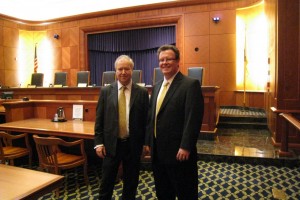The ICLR in Boston: A visit to the Massachusetts Supreme Judicial Court
While the ICLR team was in Boston for the annual conference of the International Bar Association, two of us took the opportunity to meet up with the Chief Reporter of Decisions at the Massachusetts Supreme Judicial Court. Brian H Redmond heads up a team of reporters and editors who are employed by the court, which
While the ICLR team was in Boston for the annual conference of the International Bar Association, two of us took the opportunity to meet up with the Chief Reporter of Decisions at the Massachusetts Supreme Judicial Court.
Brian H Redmond heads up a team of reporters and editors who are employed by the court, which sits in the John Adams Courthouse in downtown Boston. He kindly showed us round the courts there (including also the Appeals Court) and told us a bit about how they work and how their decisions are reported.
The John Adams Courthouse
The first thing to be said about the building is that, though not much to look at on the outside, its Great Hall (right) is magnificent. It is built in the 18th century neo-classical style, with stately columns and balustrades and a beautifully painted barrel-vaulted ceiling featuring at its centre the seal of the Commonwealth.
On the floor of the hall is a bronze statue of the 19th century attorney and statesman Rufus Choate, whose brazen foot has been worn to a glossy shine by passing attorneys and litigants hoping to channel a bit of luck for their cases.
The Supreme Judicial Court
The Supreme Judicial Court was established in 1692 to bring an end to the Salem witch trials, and is the American nation’s oldest continuously sitting appellate court. The seven justices of the court enforce the Constitution of the Commonwealth of Massachusetts, drafted by the great American patriot John Adams in 1779 and ratified in 1780, which is claimed to be “the oldest written constitution in the world still being enforced” (unless perhaps you count the English Bill of Rights 1689) and was a critical model for the US Constitution and others.
Hearings in the Supreme Judicial Court are conducted in a very different manner from those in our own appellate and supreme courts. At the entrance to the court we were shown a daily cause list on which were about eight cases. We were told all of these would be disposed of by lunchtime. The reason is that each side in each case is given a 15-minute slot to make their pitch. In front of the central lectern from where they address the bench is a small device displaying three coloured lights, a bit like traffic lights. Green is good for 14 minutes; yellow shows there is only one minute left; red means it’s time to stop. The parties are referred to as appellant and appellee. Webcasts of the oral argument are broadcast and archived.
The justices issue written opinions giving their decision within 130 days following oral arguments. Transcripts of their decisions, known as the “slip opinions”, are available online the same day, via the Massachusetts Reports website.
The Massachusetts Reports
Unlike the ICLR, which is a non-profit body of official status but without any official funding, the Massachusetts Reports are produced under statute and funded by the state. Subject to that and a couple of other minor differences, our roles are substantially similar.
The office of the Reporter of Decisions of the Massachusetts Supreme Judicial Court and Appeals Court was established under an Act of the Massachusetts Senate and House of Representatives (Acts 1803, c 133) in order “to obtain true and authentic reports of the [courts’] decisions”. On 12 October 1805 the first appointed Reporter of Decisions, Ephraim Williams, wrote in a preface to the first edition of the Massachusetts Reports:
It has long been a subject of complaint, in this state, that we had no reports of the decisions of our courts of judicature. The importance of having authentic reports of cases argued and determined in the Supreme Judicial Court, the only court in the state whose decisions are considered as authorities, must be obvious to all who have any pretensions to information on the subject.”
This chimes rather remarkably, or perhaps predictably, with the complaint made by WTS Daniel QC in a letter to the Solicitor-General, Sir Roundell Palmer in 1863, concerning the “enormous expense, prolixity, delay and irregularity in publication” of the various privately produced law reports series then available, and of their “imperfection as a record, for want of continuity”. It is perhaps to the shame of the state of England and Wales that it took another sixty years to reach the same conclusion as the Commonwealth of Massachusetts had done in 1803, as to the need for authentic, reliable and moderately priced law reports of the decisions of the superior courts that make, explain or illustrate new points of law. This happened here in 1865, with the establishment (by the four current Inns of Court, together with the now defunct Serjeants Inns, and the Law Society) of the Incorporated Council of Law Reporting for England and Wales (ICLR).
The Massachusetts Reports (cited by volume number as 123 Mass. 456 etc) have been published since 1804. They differ from English law reports in a number of ways, both in how they are produced and it what they contain.
Advance Sheets
The first report of a case comes within nine days of the issue of the slip opinion (see above). It is contained within a printed part issued weekly and known as the “advance sheets”. The reporters have access to each draft opinion for a month prior to the decision being handed down, enabling them to check quotations and citations and ensure the accuracy of the contents (much as ICLR does, but usually only after judgment is given). The reporter will then draft a set of subject matter catchwords (brief index or topic headings identifying the issues), a headnote (summarising the decision in the form of one or more propositions of law), and a procedural introduction. Names of parties, judges and representatives are also listed.
All of this is much as a regular reader of English law reports would expect. The main difference so far is that in England, and in other Commonwealth countries such as Canada, Australia, New Zealand etc, we would expect the headnote to consist generally of two portions: a factual introduction, outlining the origins and nature of the dispute, and then one or more “holdings” (after the magic word “Held”) expressing the legal propositions. So they tend to look a bit longer than the more condensed US version. (That’s not to say that other American reporters might not take a different approach; and indeed the US Reports series, covering the US Supreme Court, contains a “syllabus” which is more akin to the fuller English style of headnote.)
The Bound Volume
The advance sheets are essentially a first edition of the report, subject to amendment and correction before the weekly parts are bound together in a hardback volume. The bound volume is then the definitive, authorised report of the case, and should be cited in preference to any earlier version. There may be two or three volumes in a year, which is why they are numbered sequentially, rather than by year as is commonly done in England.
Coverage and selection
Another difference from English law reports is that there is no selection of cases by the reporter. Rather, it is the court’s decision whether a case should NOT be reported, the default position being that all decisions of the Supreme Judicial Court are reported, and many of those from the Appeals Court. However, by Rule 1:28, the court may order that an appeal decision not be published where the decision itself merely follows existing law and provides no authority for anything. These unreported decisions are nevertheless listed in the back pages of the Appeals Court volume of the reports, and their contents may be viewed online.
The selection of cases is a two-edged sword, as far as law reporting is concerned. In the days before most new judgments were available free online, it gave the reporter a sort of “gateway” or “custodian” function, determining which cases would be available for public and professional perusal, and which were best left to gather dust. Some of the dust-gatherers turned out to be rather more important than was first perceived. The existence of rival publishers ensured that the number of wrongly neglected cases was few; and the great benefit of selection (often urged by the judiciary) was that it avoided excessive citation of authorities which added nothing to the store of human knowledge.
Now that most judgments are readily available online within hours of being handed down, the law reporter’s “gatekeeper” role has receded: the distinction is now between what Lord Neuberger, President of the Supreme Court, called “judgment dissemination” (usually free, on the internet) and “judgment enhancement” (scholarly law reporting) as applied to the far fewer but more important cases that genuinely merit it. (See, generally, the first BAILII Annual Lecture, entitled “No Judgment, No Justice”, given by Lord Neuberger on 20 November 2012.)
The Massachusetts Law Reports website performs both functions. It allows all recent slip opinions to be searched and retrieved; but it also publishes (for access by existing subscribers) the advance sheet edition of the “enhanced” law report. Though it looks quite old fashioned, it does the job. Likewise the reports themselves, maintaining a tradition going back more than 200 years.
